Our Library
Explore our publications, from research papers and series to educational materials, covering all aspects of conflict transformation and peace promotion.
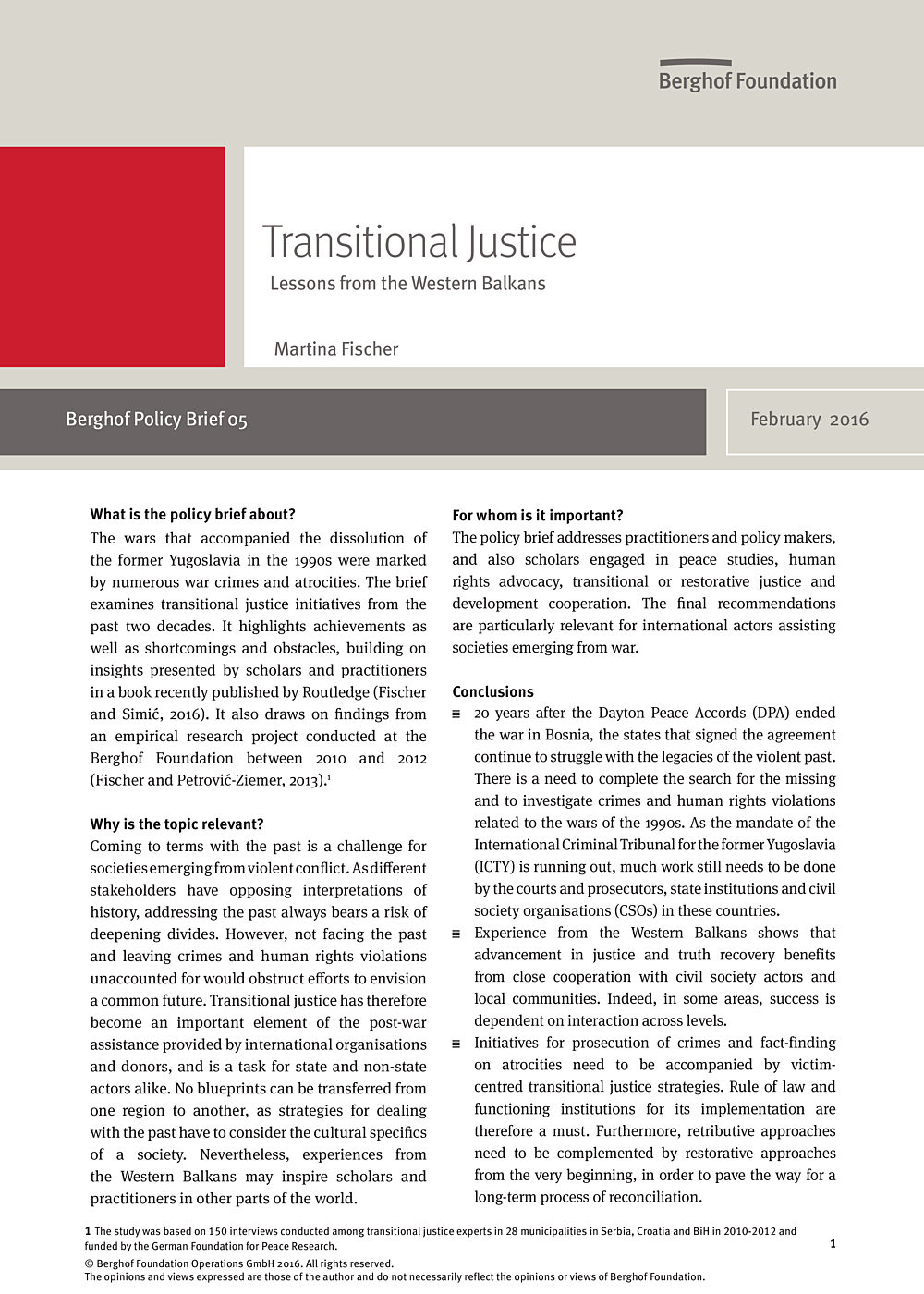
Transitional Justice: Lessons from the Western BalkansPolicy Brief No. 5
The policy brief examines different approaches and initiatives for transitional justice and reconciliation that have been implemented since the Dayton Peace Accords (DPA) ended the war in Bosnia in 1995. It highlights achievements and innovative approaches in processes of dealing with the past as well as shortcomings and obstacles for reconciliation.
- Year2016
- Author(s)Martina Fischer
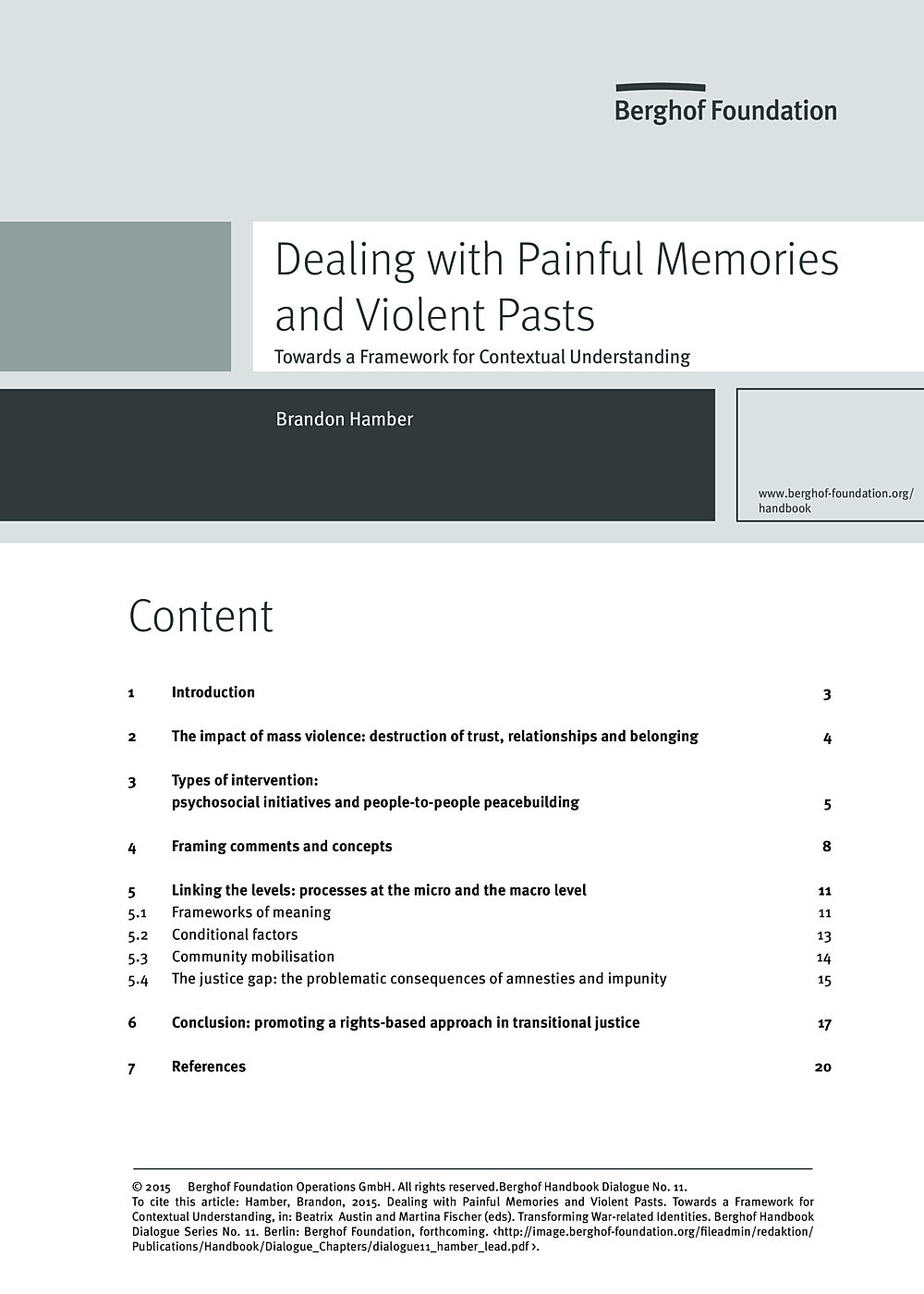
Dealing with Painful Memories and Violent Pasts. Towards a Framework for Contextual UnderstandingHandbook Dialogue Series No. 11 - lead article
Reflects on the role of different approaches for dealing with painful memories and violent pasts. The author explores how different dimensions – interpersonal and intergroup relations, memories and identities at the individual and collective level – relate to one another. He also addresses how one can constructively address victim identities and cultures of victimhood that may stem from painful or traumatic experiences in light of his work in South Africa and Northern Ireland, among other locales.
- Year2015
- Author(s)Brandon Hamber
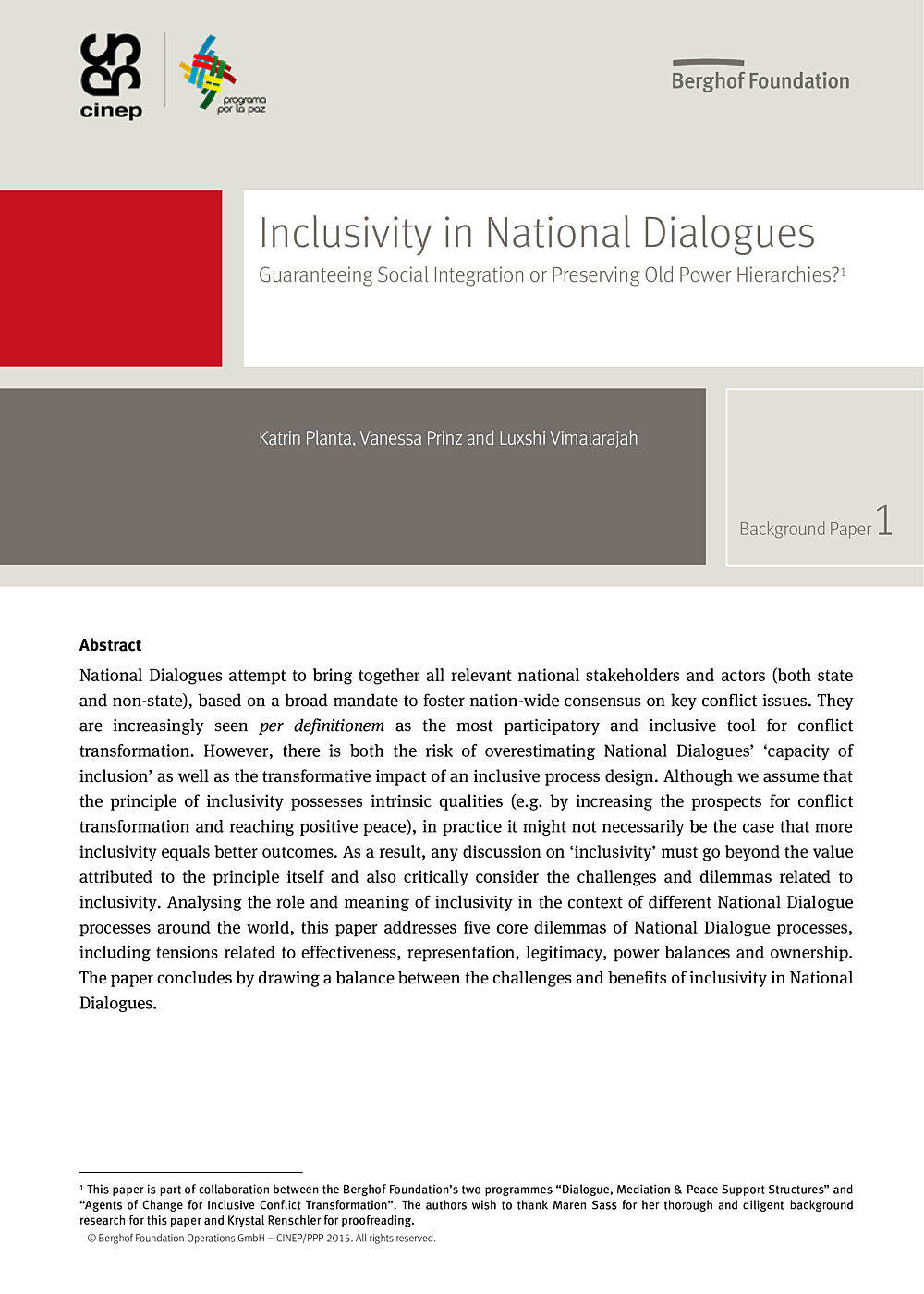
Inclusivity in National Dialogues: Guaranteeing Social Integration or Preserving Old Power Hierarchies?IPS Paper No.1
Analysing the role and meaning of inclusivity in the context of different National Dialogue processes around the world, this paper addresses five core dilemmas of National Dialogue processes, including tensions related to effectiveness, representation, legitimacy, power balances and ownership.
The paper concludes by drawing a balance between the challenges and benefits of inclusivity in National Dialogues.
- Year2015
- Author(s)Katrin Planta, Vanessa Prinz, Luxshi Vimalarajah
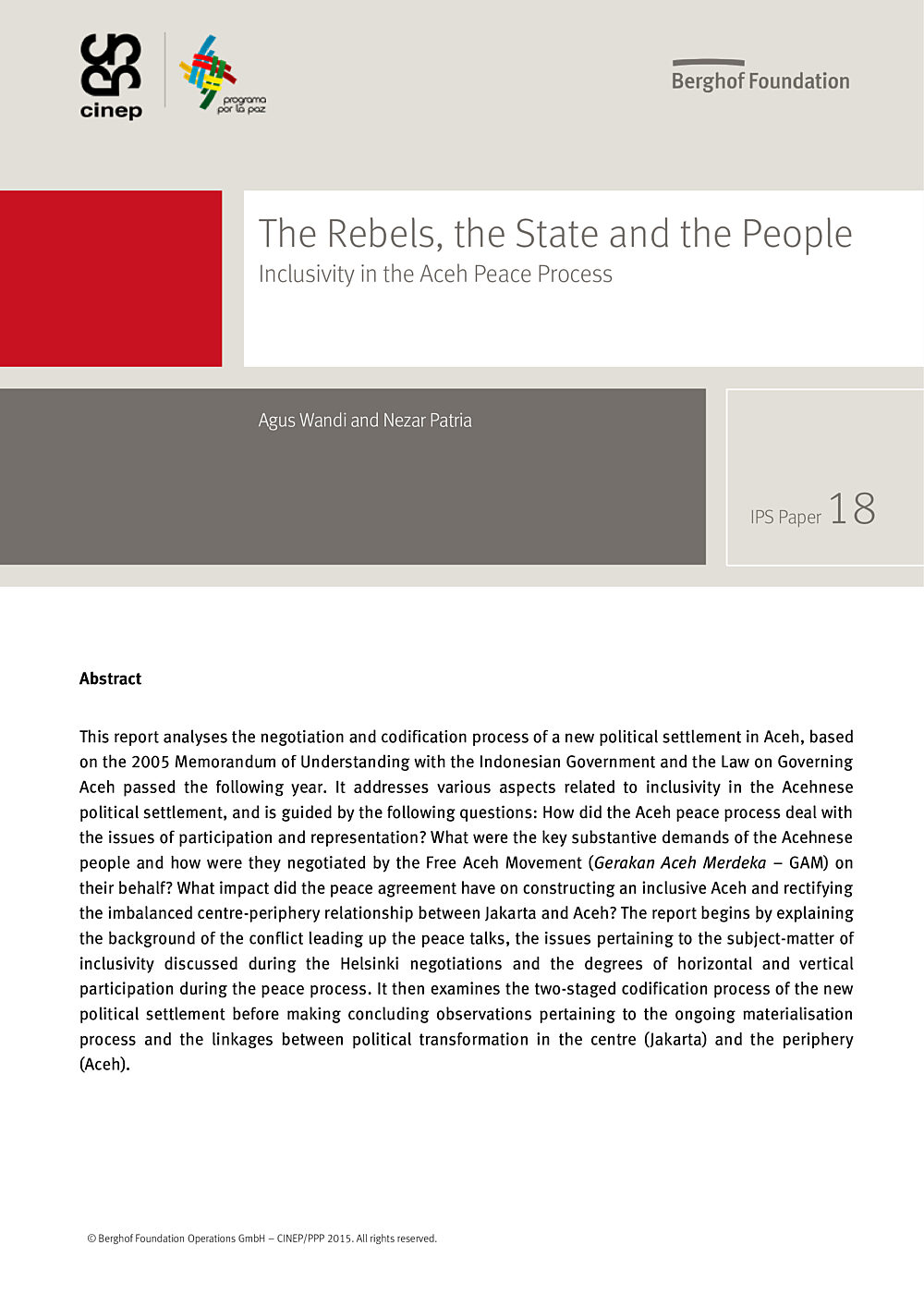
The Rebels, the State and the People: Inclusivity in the Aceh Peace ProcessIPS Paper No. 18
This report analyses the negotiation and codification process of a new political settlement in Aceh, based on the 2005 Memorandum of Understanding with the Indonesian Government and the Law on Governing Aceh passed the following year. It addresses various aspects related to inclusivity in the Acehnese political settlement, and is guided by the following questions: How did the Aceh peace process deal with the issues of participation and representation? What were the key substantive demands of the Acehnese people and how were they negotiated by the Free Aceh Movement (Gerakan Aceh Merdeka – GAM) on their behalf? What impact did the peace agreement have on constructing an inclusive Aceh and rectifying the imbalanced centre-periphery relationship between Jakarta and Aceh?
- Year2015
- Author(s)Agus Wandi, Nezar Patria
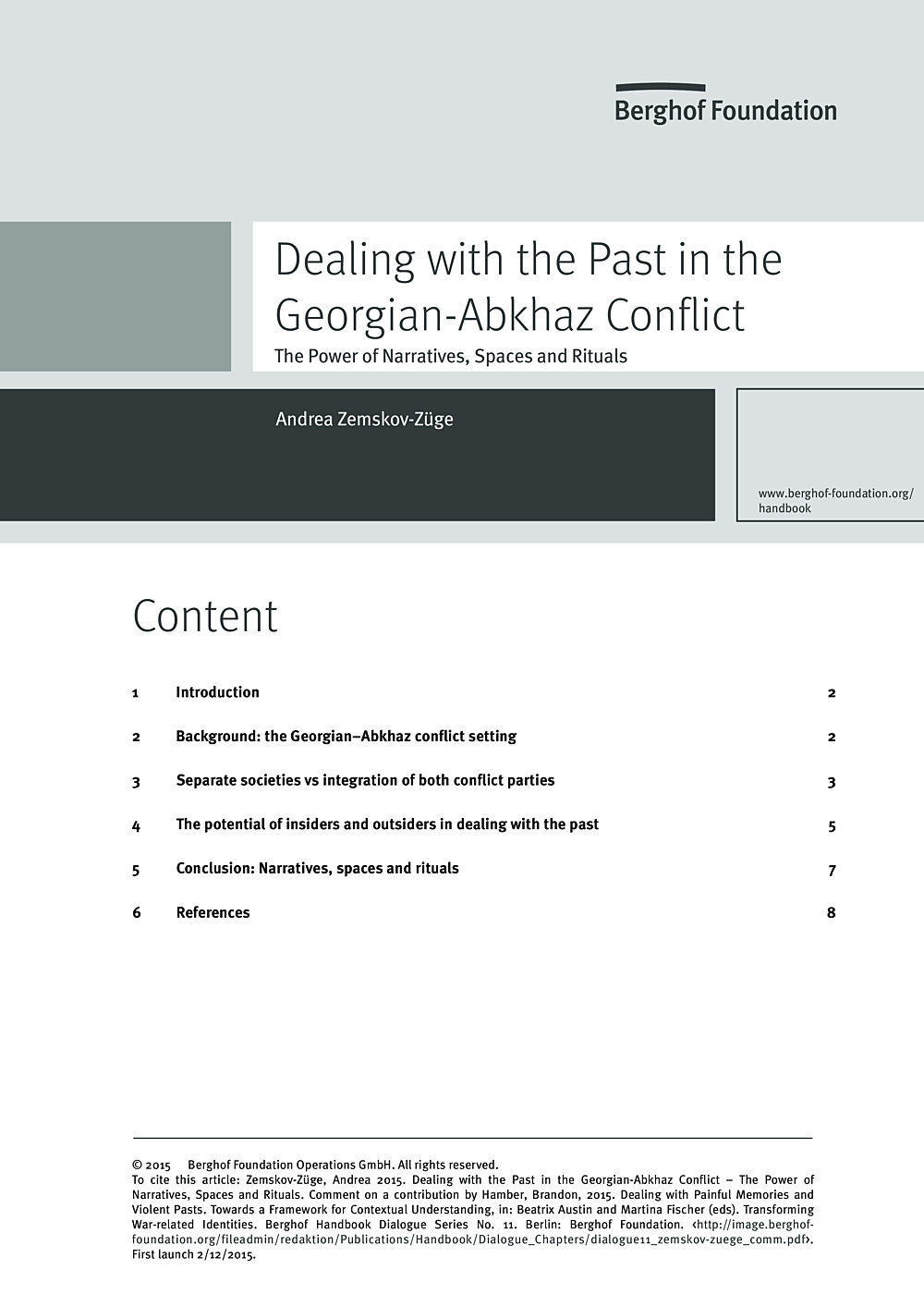
Dealing with the Past in the Georgian-Abkhaz Conflict: The Power of Narratives, Spaces and RitualsBerghof Handbook Dialogue Series No. 11 - comment
Brandon Hamber’s essay addresses two important questions: “What is the role of different approaches for dealing with painful memories and violent pasts?” and “How do the different dimensions – interpersonal and intergroup relations, memories, and identities at the individual and collective level – relate to one another?” (Hamber 2015, 2). These questions open up a universe of additional topics related to the cultural context, societal preconditions and obstacles to dealing with the past in post-war societies. I read his remarks against the background of my field of work in the South Caucasus. Here I engage as a historian, having specialised in Soviet and post-Soviet war memory, and as a dialogue practitioner striving to make use of scientific concepts and findings for establishing a sound and resilient peacebuilding system in the region.
- Year2015
- Author(s)Andrea Zemskov-Zuege

الوسطاء الداخليوندراسة حول استكشاف دورهم الرئيسي في عمليات السالم غير الرسمية
يسـلط هـذا التقريـر الضـوء علـى مجموعـة رئيسـية مـن األطـراف الفاعلـةُ ّعـد هـذا التقريـر بنً ـاء علـى فـي عمليـات السـام: الوسـطاء الداخلييـن. وقـد أ الخبـرة المكتسـبة أن أغلـب عمليـات السـام الرسـمية قـد بـدأت مـن خـالُ لحقـت بهـا، وقـام أنـاس متفانـون مـن مناطـق عمليـات سـام غيـر رسـمية أو أ الصـراع وعلـى معرفـة متعمقـة بـه بتسـهيل عمليـات السـام تلـك. مــن أجــل استكشــاف الــدور المحــدد للوســطاء "الداخلييــن" المحلييــن واإلقليمييــن فــي عمليــات الســام الحاليــة، قامــت مؤسســة بيرغهــوف، بالتعـاون مـع مشـروع دعـم الوسـاطة التابـع لمؤسسـة السـام السويسـرية ومركــز الدراســات األمنيــة )CSS )فــي المعهــد السويســري الفيدرالــي للتكنولوجيــا ETH بزيوريــخ، بدعــوة مجموعــة مــن الوســطاء الداخلييــن مــن مختلــف أنحــاء العالــم )الجزائــر، بورونــدي، جمهوريــة الكونغــو الديمقراطيــة، ألمانيــا، كينيــا، قيرغيزســتان، مقدونيــا، مالــي، المكســيك، نيبــال، الفلبيــن، ســريالنكا، سويســرا وأوغنــدا(.
- Year2015
- Author(s)Simon Mason
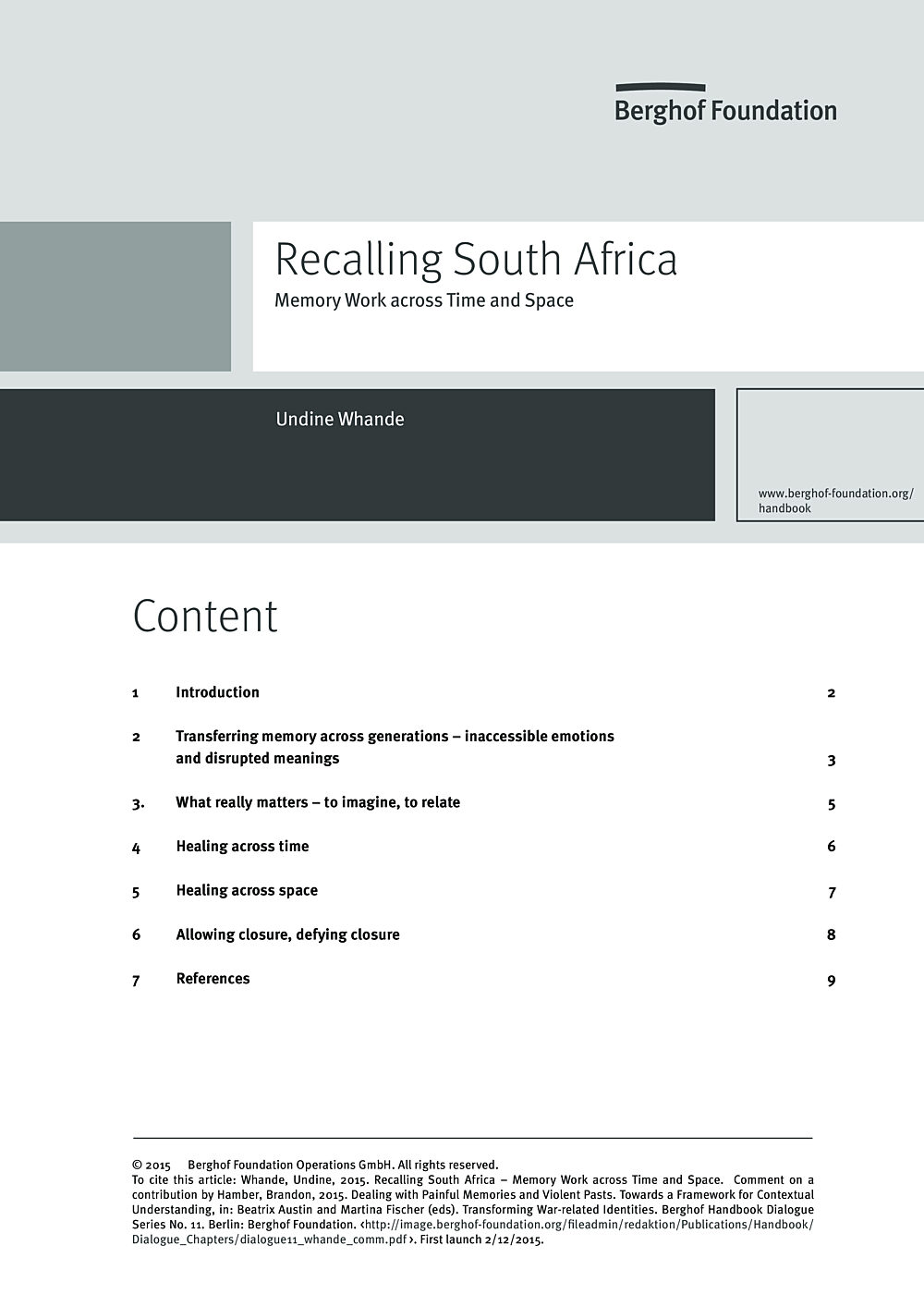
Recalling South Africa – Memory Work across Time and SpaceBerghof Handbook Dialogue Series No. 11 - comment
I remember well the time of the Truth and Reconciliation Commission (TRC). I had come to South Africa a few months before the start of the first hearing, as a “bright-eyed and bushy-tailed” twenty-something enthusiastic about witnessing and partaking in this time of transformation in the country. At that time I only knew South Africa from my youthful times of rebellion in the German anti-apartheid movement. I loved the sincerity and courage with which South Africans approached the task, even though it was clear from the start that this would be a tremendously painful exercise. I recall going to one of the first hearings of the TRC and being warmly welcomed when I shared my interest in memory work based on my experience of having led youth exchange visits to concentration camps in Poland and inter-generational dialogue projects in Germany.
- Year2015
- Author(s)Undine Whande
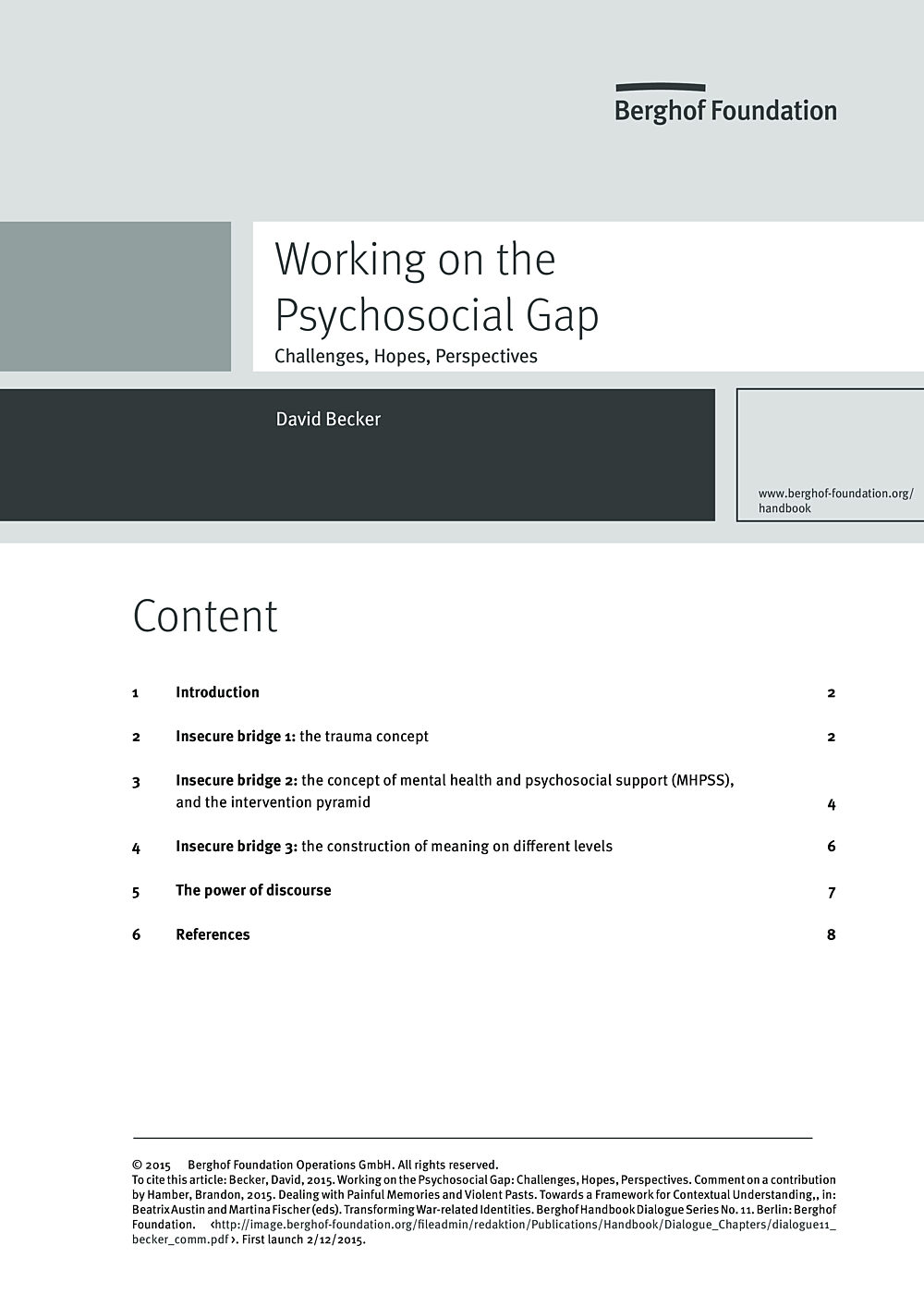
Working on the Psychosocial Gap: Challenges, Hopes, PerspectivesBerghof Handbook Dialogue Series No. 11 - comment
In his scholarly article, “Dealing with painful memories and violent pasts”, Brandon Hamber explains and reflects on “the relationship between how individual (largely victim) processes of coming to terms with mass atrocity (a micro perspective) relate to the collective or political process of finding ways of dealing with the past (a macro perspective)” (Hamber 2015, 2). In any discussion of war, mass atrocities, political repression and their impact, one is unavoidably forced to think about this relationship and deal with it – to confront the challenge of having to talk about both perspectives without being able to fully integrate them or grasp their linkage in all its complexity. Hamber does a masterful job in confronting this inherent problem but inevitably succumbs, at least in part, to the impossibility of the task. The reason for this might be what I call “the psychosocial gap”, and I believe this needs closer examination.
- Year2015
- Author(s)David Becker
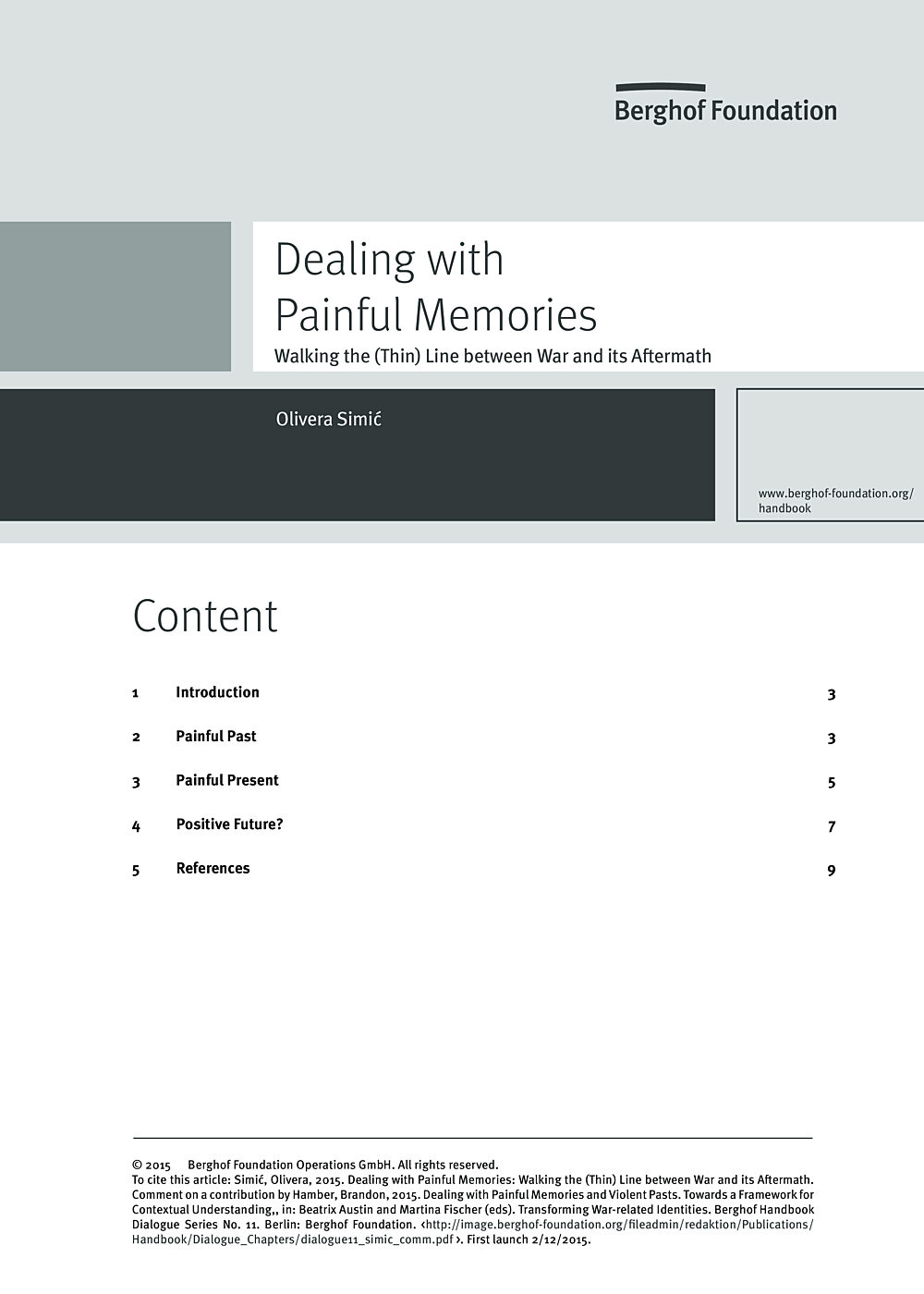
Dealing with Painful Memories: Walking the (Thin) Line between War and its AftermathBerghof Handbook Dialogue Series No. 11 - comment
As I cannot do justice in this short paper to every point Hamber makes in his engaging and thoughtful article I have chosen to discuss a few points, drawing on my personal experiences of war in my homeland Bosnia and Herzegovina (BiH). First, I will provide an overview of the war in BiH and its nexus with trauma. I will question the transition process, reflecting on the blurred line between “conflict” and so-called “postconflict”, and argue that war in BiH is not over yet; it is just being fought with other means. In the second part of the paper, I will discuss competing victimhood(s), ethnic identities and the parallel narratives that are a feature of the BiH transitional processes and that present obstacles to any attempts at reconciliation. Finally, I will suggest that in order to build a shared narrative of war it is important to intertwine the experiences of all victims and to draw on positive stories of courage and sacrifice in the midst of war, to restore the faith of Bosnian people in humanity and coexistence.
- Year2015
- Author(s)Olivera Simić
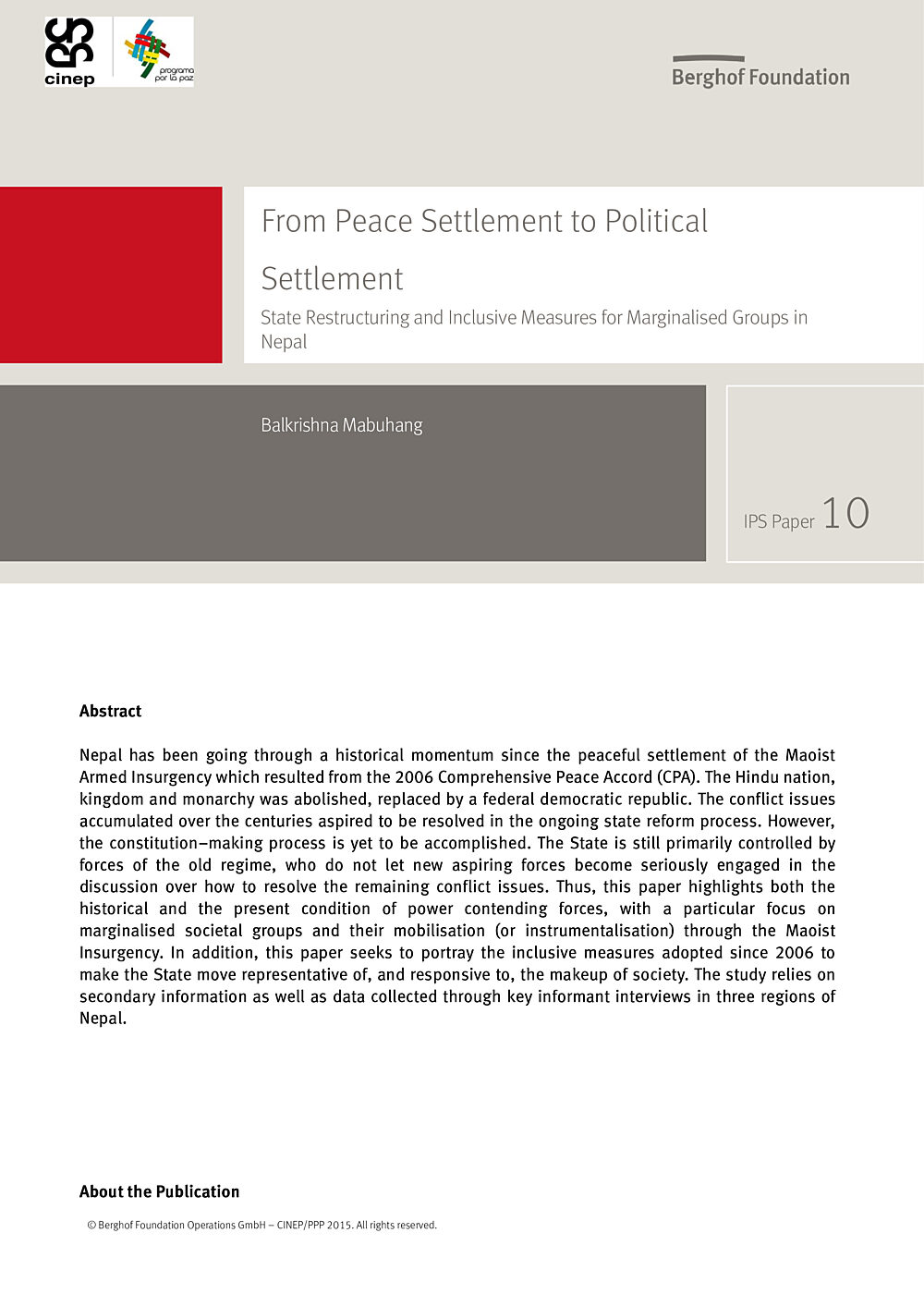
From Peace Settlement to Political Settlement: State Restructuring and Inclusive Measures for Marginalised Groups in NepalIPS Paper No. 10
This paper highlights both the historical and the present condition of power contending forces, with a particular focus on marginalised societal groups and their mobilisation (or instrumentalisation) through the Maoist Insurgency. In addition, this paper seeks to portray the inclusive measures adopted since 2006 to make the State move representative of, and responsive to, the makeup of society. The study relies on secondary information as well as data collected through key informant interviews in three regions of Nepal.
- Year2015
- Author(s)Balkrishna Mabuhang